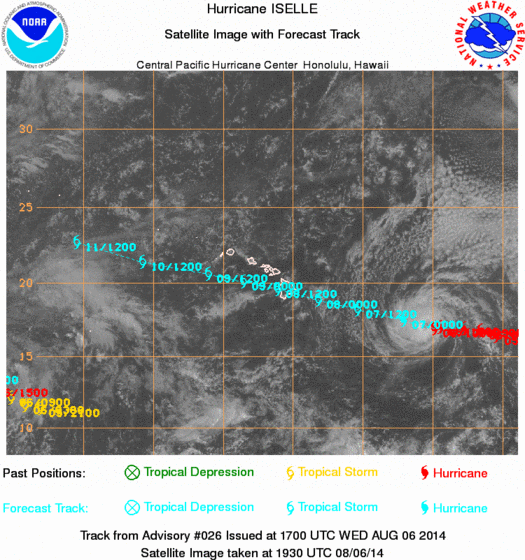Anticipating Cyclones, Governor Signs Emergency Proclamation
By Maui Now Staff
Governor Neil Abercrombie today signed an emergency proclamation in anticipation of the arrival of two tropical cyclones in Hawaiʻi.
Hurricane Iselle is forecast to impact the state Thursday evening through late Friday, and Hurricane Julio is a few days behind Iselle and may impact the islands as soon as Sunday.
The proclamation, which includes the entire state, activates the Major Disaster Fund set aside by the Legislature for disaster relief. It also allows easier access to emergency resources at the state and federal levels, along with the suspension of certain laws as needed for emergency purposes, according to the governor.
“We want to make sure we are doing everything possible to protect the public,” said Abercrombie in a press release. “This proclamation improves the state’s ability to respond quickly to any potential impacts from both storms.”
The disaster emergency relief period for the proclamation begins today and continues through Friday, Aug. 15, 2014.
Mayor Alan Arakawa has also declared an official state of emergency for the County of Maui, effective 11:10 a.m. on August 6, 2014 and extending until further notice or automatically terminating 60 days after this issuance.
The Federal Emergency Management Agency lists the following recommended items for a basic emergency supply kit:
- Water, one gallon of water per person per day for at least three days, for drinking and sanitation
- Food, at least a three-day supply of non-perishable food
- Battery-powered or hand crank radio and a NOAA Weather Radio with tone alert and extra batteries for both
- Flashlight and extra batteries
- First aid kit
- Whistle to signal for help
- Dust mask to help filter contaminated air and plastic sheeting and duct tape to shelter-in-place
- Moist towelettes, garbage bags and plastic ties for personal sanitation
- Wrench or pliers to turn off utilities
- Manual can opener for food
- Local maps
- Cell phone with chargers, inverter or solar charger
Once you have gathered the supplies for a basic emergency kit, FEMA suggests you may want to consider adding the other following items:
- Prescription medications and glasses
- Infant formula and diapers
- Pet food and extra water for your pet
- Cash or traveler’s checks and change
- Important family documents such as copies of insurance policies, identification and bank account records in a waterproof, portable container. You can use the Emergency Financial First Aid Kit – EFFAK (PDF – 977Kb) developed by Operation Hope, FEMA and Citizen Corps to help you organize your information.
- Emergency reference material such as a first aid book.
- Sleeping bag or warm blanket for each person. Consider additional bedding if you live in a cold-weather climate.
- Complete change of clothing including a long sleeved shirt, long pants and sturdy shoes. Consider additional clothing if you live in a cold-weather climate.
- Household chlorine bleach and medicine dropper – When diluted, nine parts water to one part bleach, bleach can be used as a disinfectant. Or in an emergency, you can use it to treat water by using 16 drops of regular household liquid bleach per gallon of water. Do not use scented, color safe or bleaches with added cleaners.
- Fire extinguisher
- Matches in a waterproof container
- Feminine supplies and personal hygiene items
- Mess kits, paper cups, plates, paper towels and plastic utensils
- Paper and pencil
- Books, games, puzzles or other activities for children
The American Red Cross lists the following tips to prepare for a hurricane:
- Listen to a NOAA Weather Radio for critical information from the National Weather Service.
- Check your disaster supplies. Replace or restock as needed.
- Bring in anything that can be picked up by the wind (bicycles, lawn furniture).
- Close your windows, doors and hurricane shutters. If you do not have hurricane shutters, close and board up all windows and doors with plywood.
- Turn your refrigerator and freezer to the coldest setting. Keep them closed as much as possible so that food will last longer if the power goes out.
- Turn off propane tank.
- Unplug small appliances.
- Fill your car’s gas tank.
- Create a hurricane evacuation plan with members of your household. Planning and practicing your evacuation plan minimizes confusion and fear during the event.
- Find out about your community’s hurricane response plan. Plan routes to local shelters, register family members with special medical needs and make plans for your pets to be cared for.
- Obey evacuation orders. Avoid flooded roads and washed out bridges.










